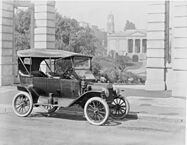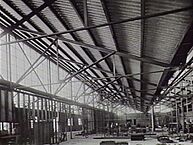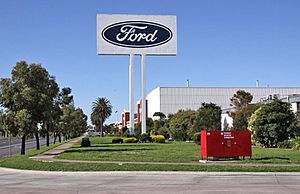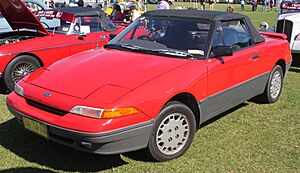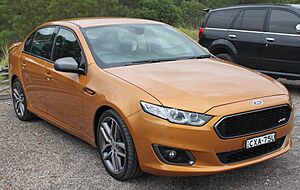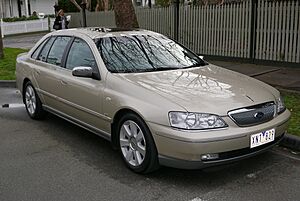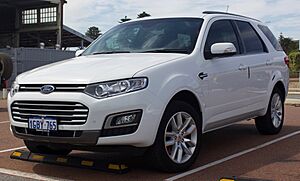Ford Australia facts for kids
 |
|
| Subsidiary | |
| Industry | Automotive |
| Founded | 1925 |
| Founder | Henry Ford |
| Headquarters | Richmond, Victoria (Head Office) Broadmeadows Assembly Plant (Asia Pacific Engineering Centre) |
|
Key people
|
Andrew Birkic (president & CEO) |
| Products |
|
|
Number of employees
|
1,800 (2023) |
| Parent | Ford Motor Company |
Ford Motor Company of Australia Limited, often called Ford Australia, is the Australian part of the American car company Ford Motor Company. It started in 1925 as a branch of Ford Canada. Back then, Ford Canada was a separate company from Ford in the US. Henry Ford had given Canadian investors the right to make Ford cars in the British Empire.
Ford Australia's first cars were Model Ts. These cars were put together from special kits sent from Ford of Canada. Many models followed, but the most famous was the Falcon. It was made from 1960 to 2016. The Falcon started as a US model but was changed to suit Australian roads.
Contents
History of Ford Australia
Early Car Making
On March 31, 1925, Ford announced its main office would be in Geelong, Victoria. The first Ford car built in Australia was a Model T. It was launched on July 1, 1925. The first production line was in an old wool warehouse in Geelong. A new factory was being built a few miles away in an area now called Norlane. While the Geelong plant was being built, another company, Holden's Motor Body Builders Ltd, made car bodies for Ford Australia. In 1928, the factory started making the Model A. This was followed by the Ford V8 in 1932.
In 1934, Ford Australia released a special car called a coupé utility. It was based on a US Ford pickup truck. A local Ford engineer named Louis (Lewis) Bandt designed it. During the Great Depression, banks would not lend money to farmers for regular cars. They said cars were not needed. But they would lend money for "working" vehicles. The coupé utility was perfect for farmers. It could be used for work and also to take the family to church.
In 1956, the company bought land in Campbellfield, a suburb of Melbourne. They built the Broadmeadows Assembly Plant there. In July 1961, Ford announced that this new Melbourne factory would become the company's main office.
End of Australian Car Production
Around 2009, Ford's main company in the US started to stop some projects overseas. This was to avoid serious financial problems. By July 2009, Ford Australia had permission to add a new small car to its Falcon production line. However, on May 23, 2013, Ford Australia announced it would stop making cars in Australia. This decision came after 88 years of car production. The reasons were high manufacturing costs and lower car sales. The company had lost a lot of money in the years before. About 1200 workers lost their jobs because of this.
Ford had two main factories in Victoria. One was in Norlane, Geelong, and the other in Campbellfield, Melbourne. The Ford Discovery Centre, a museum about Ford's history in Australia, also closed.
From 1972 to 2016, Ford Falcons were fully designed in Australia. The company also made the Territory SUV. Its production also ended in 2016. The Falcon's production stopped when the Broadmeadows and Geelong factories closed. The Geelong factory made its last Australian-made engines on September 26, 2016. Car assembly at Broadmeadows finished on October 7, 2016. This marked the end of Ford's 88 years of car manufacturing in Australia.
Ford Australia was one of Ford's five global product development centers. Since the factories closed in 2016, Ford Australia now imports all its cars and trucks. These vehicles are sold in the Asia/Pacific region. About 1300 workers remained in Australia for design and engineering roles.
Ford Australia's Facilities
Ford Australia was chosen as one of five worldwide centers for developing new products. This center focused on the Asia Pacific and African regions. Some products developed there included the Ford Ikon and Fiesta for India. They also developed the Ford Bantam ute and Ikon for South Africa. The new Ranger pickup truck was also developed there.
On January 24, 2019, over 100 engineers and designers lost their jobs at Ford in Victoria. This included workers at Ford sites in Broadmeadows, Lara, and Geelong. Ford said that engineering work for its Ranger ute and other models would now be led from the United States. The remaining Australian engineers would help develop a new medium-sized pickup truck for Ford and a German brand.
Car Models Made in Australia
Ford Australia began by putting together Model Ts. As Ford released new models, they were also assembled in Australia. During World War II, Ford Australia stopped making cars. Instead, they made military equipment to help with the war.
After World War II, Ford started assembling imported Ford models again. First, they assembled the UK-made Pilot. Then, they made a range of British cars. These included the Prefect, Anglia, Consul, Zephyr, and Zodiac. Ford also assembled the Canadian Ford V8.
Hatchback Cars
The Ford Laser was made at Ford's factory in Flemington, Sydney. This happened from 1981 until September 1994. After the factory closed, Lasers were imported from Japan. The Laser was replaced by the Ford Focus in 2002. The Fiesta, a global Ford car, was also sold in Australia between 2004 and 2022.
Mid-size Cars
Mid-size cars once assembled in Australia included the Ford Cortina, Capri, and Escort. These cars came from the UK. They were changed for the Australian market. For example, from 1972, the Cortina could have a larger engine. In 1977, the Cortina wagon was even assembled in another company's factory.
The Cortina was replaced by the Telstar. This car was based on the Mazda 626 and was first assembled in Australia. In 1989, the Telstar sedan was replaced by the Ford Corsair. This was basically a Nissan Pintara with a Ford badge. When Nissan stopped making cars in Australia in 1992, the Telstar name came back. It was again a Mazda 626 with Ford badges. In 1995, the Telstar was replaced by the Mondeo. This car was imported from Belgium.
Ford Australia stopped selling the Mondeo in 2001. They said that type of car was not as popular anymore. But in 2007, they announced they would bring the new Mondeo model to Australia.
Large Cars
The Ford Falcon was made in Australia based on a North American design. The first one rolled off the line at Ford's Broadmeadows plant on June 28, 1960. It was very similar to the American design. However, the Falcon soon struggled on Australia's rough roads. This led to a big effort to make it more reliable. By the mid-1960s, the car was quite different from its North American version. It was sold as a sedan, wagon, coupé, utility, and panel van.
The North American Falcon, which the Australian Falcon was loosely based on, stopped production in 1970. This meant Ford Australia had to design its own Falcon. The first truly all-Australian Ford Falcon was the XA model, launched in June 1972. Later Falcons, like the XD and XE (1979-1984), looked similar to some European Fords. But they were still fully Australian in their engineering and parts.
The Falcon was an "automotive icon" in Australia for most of its 56 years. It was a big part of Australian culture and car racing. Falcons were used as taxis, police cars, family cars, and work vehicles. They won many times in the Australian Touring Car Championship. They also won the annual Bathurst 1000 race. The Falcon's reputation for great engineering was set by the early 1970s. This was thanks to powerful versions like the Falcon GT and GTHO.
Ford made over four million Falcons between 1960 and 2016. It was often the best-selling car. By 2016, the Falcon was only sold as a sedan and a utility vehicle. In the past, there were also panel vans, station wagons, and hardtops. Falcons were very popular as taxis in Australia and New Zealand. Performance versions of the Falcon were used by police for many years.
Luxury Cars
Ford Australia also made large luxury cars alongside the Falcon. These models were called the Fairlane and the LTD. The first Fairlane, released in 1959, was an Australian-assembled version of the US Fairlane. US cars continued to be assembled until 1967. Then, Ford Australia designed its own luxury car, the ZA Fairlane. It was based on the Falcon but had a longer body and small style changes.
Ford Fairlanes were often chosen by politicians and business people. In 1972, a new model, the LTD, joined the Fairlane range. It was a Fairlane with more features, like hidden headlights and a vinyl roof. From the third generation of Fairlane onwards, the LTD shared the same body as the Fairlane. It was sold as a more luxurious version of the Fairlane.
The Fairlane was the top-selling luxury car in Australia for twenty years. But its popularity slowly dropped in the late 1980s. More European luxury cars like BMW and Mercedes Benz were imported. By the year 2000, the Fairlane was outsold by the Holden Statesman. In 2007, Ford Australia announced it would stop making the Fairlane and LTD. This was due to falling sales and an uncertain future for large luxury cars.
SUV Cars
Between 2004 and 2016, the Ford Territory was built on the same production line as the Falcon. The Territory, which is a type of crossover, was often the most popular SUV in Australia.
Ford Australia's Car Range
Current Car Range
- Ford Mustang
- Ford Mustang Mach-E
- Ford Everest
- Ford Ranger
- Ford F-150
- Ford Tourneo
- Ford Transit Custom
- Ford Transit
Former Car Range
- Ford Pilot (1949–1951)
- Ford Mainline (1952–1959)
- Ford Customline (1952–1959)
- Ford Prefect (1939–1961)
- Ford Custom (1949–1962)
- Ford Zephyr (1951–1962)
- Ford Consul (1956–1962)
- Ford Anglia (1939–1967)
- Ford Galaxie (1964–1972)
- Ford Landau (1973–1976)
- Ford Escort (1970–1981)
- Ford Cortina (1964–1982)
- Ford Meteor (1981–1987)
- Ford Bronco (1981–1987)
- Ford Corsair (1989–1992)
- Ford Capri (1969–1972, 1989–1994)
- Ford Telstar (1982–1994)
- Ford Maverick (1988–1994)
- Ford Probe (1994–1997)
- Ford Taurus (1996–1998)
- Ford Festiva (1991–2000)
- Ford Laser (1981–2002)
- Ford Cougar (1999–2002)
- Ford Ka (1999–2003)
- Ford Econovan (1980–2004)
- Ford Explorer (1996–2005)
- Ford Courier (1973–2007)
- Ford Fairlane (1967–2007)
- Ford Territory (2004–2016)
- Ford Falcon (1960–2016)
- Ford Endura (2018–2020)
- Ford Ecosport (2013–2020)
- Ford Mondeo (1995–2000, 2007–2020)
- Ford Focus (2003–2022)
- Ford Fiesta (2004–2022)
- Ford Escape (2001–2023)
Sponsorships
Ford Australia is a big supporter of the Geelong Football Club. Their sponsorship deal started in 1925. This makes it the longest sports sponsorship in the world.
In August 2023, Ford Australia announced a new partnership with Basketball Australia. As part of this deal, the Ford logo appears on the jerseys of Australia's men's and women's national basketball teams.
In 1962, Ford sponsored a soccer club called IASCOG. The club was renamed the Morwell Falcons. This was to honor the newly launched car. Over the years, the Falcons became very successful. They are the only Australian club to rise from a local league to the top national soccer league.
Ford Australia also works with Deakin University. They fund the Ford Australia Women in STEAM Scholarship. This scholarship helps women study science, technology, engineering, arts, and math.


